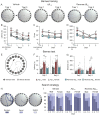Systematic characterization of a non-transgenic Aβ1-42 amyloidosis model: synaptic plasticity and memory deficits in female and male mice
- PMID: 37716988
- PMCID: PMC10504764
- DOI: 10.1186/s13293-023-00545-4
Systematic characterization of a non-transgenic Aβ1-42 amyloidosis model: synaptic plasticity and memory deficits in female and male mice
Abstract
Background: The amyloid-β (Aβ) cascade is one of the most studied theories linked to AD. In multiple models, Aβ accumulation and dyshomeostasis have shown a key role in AD onset, leading to excitatory/inhibitory imbalance, the impairments of synaptic plasticity and oscillatory activity, and memory deficits. Despite the higher prevalence of Alzheimer's disease (AD) in women compared to men, the possible sex difference is scarcely explored and the information from amyloidosis transgenic mice models is contradictory. Thus, given the lack of data regarding the early stages of amyloidosis in female mice, the aim of this study was to systematically characterize the effect of an intracerebroventricular (icv.) injection of Aβ1-42 on hippocampal-dependent memory, and on associated activity-dependent synaptic plasticity in the hippocampal CA1-CA3 synapse, in both male and female mice.
Methods: To do so, we evaluated long term potentiation (LTP) with ex vivo electrophysiological recordings as well as encoding and retrieval of spatial (working, short- and long-term) and exploratory habituation memories using Barnes maze and object location, or open field habituation tasks, respectively.
Results: Aβ1-42 administration impaired all forms of memory evaluated in this work, regardless of sex. This effect was displayed in a long-lasting manner (up to 17 days post-injection). LTP was inhibited at a postsynaptic level, both in males and females, and a long-term depression (LTD) was induced for the same prolonged period, which could underlie memory deficits.
Conclusions: In conclusion, our results provide further evidence on the shifting of LTP/LTD threshold due to a single icv. Aβ1-42 injection, which underly cognitive deficits in the early stages of AD. These long-lasting cognitive and functional alterations in males and females validate this model for the study of early amyloidosis in both sexes, thus offering a solid alternative to the inconsistence of amyloidosis transgenic mice models.
Keywords: Alzheimer’s disease; Amyloid-β; Aβ 1–42; Hippocampus; LTP; Sex differences; Spatial memory.
Plain language summary
This study focuses on investigating how amyloid-β (Aβ), a key toxic protein in Alzheimer's disease (AD), impacts memory and functioning of the synapses in both male and female mice.Our primary objective was to comprehensively understand the impact of Aβ1–42, a specific form of Aβ, when introduced into the brain's ventricles, focusing on memory processes associated with the hippocampus, a brain region vital for learning and memory.Prior research established Aβ's significance in AD and memory decline. However, despite the higher prevalence of AD in females, the connection between Aβ, memory, and sex differences required further exploration. Furthermore, findings from experiments utilizing Aβ transgenic mice have offered conflicting outcomes. Here, by administering Aβ1–42 to male and female mice, we systematically assessed memory using cognitive tasks. Results were consistent: memory deficits were evident in both sexes, persisting for up to 17 days post-injection.Delving deeper, we explored alterations in synaptic plasticity, a cornerstone of learning and memory. Our investigations unveiled disruptions in long-term potentiation (LTP) and long-term depression (LTD)—essential synaptic processes—in both male and female mice subjected to Aβ1–42 injection.These intriguing findings underscore Aβ1–42's lasting influence on memory and synaptic function, emphasizing its role in early AD-related cognitive decline. Additionally, our study highlights the potential of this experimental model to investigate early AD across sex differences, offering a promising alternative to the existing array Aβ transgenic mouse models and addressing the need for a more consistent investigative framework.
© 2023. Society for Women's Health Research and BioMed Central Ltd.
Conflict of interest statement
The authors declare that they have no competing interests.
Figures






Similar articles
-
Mapping the hippocampal spatial proteomic signature in male and female mice of an early Alzheimer's disease model.Biol Sex Differ. 2025 May 25;16(1):36. doi: 10.1186/s13293-025-00697-5. Biol Sex Differ. 2025. PMID: 40414897 Free PMC article.
-
Hippocampal long-term synaptic depression and memory deficits induced in early amyloidopathy are prevented by enhancing G-protein-gated inwardly rectifying potassium channel activity.J Neurochem. 2020 May;153(3):362-376. doi: 10.1111/jnc.14946. Epub 2020 Jan 30. J Neurochem. 2020. PMID: 31875959 Free PMC article.
-
Impact of blunting astrocyte activity on hippocampal synaptic plasticity in a mouse model of early Alzheimer's disease based on amyloid-β peptide exposure.J Neurochem. 2022 Mar;160(5):556-567. doi: 10.1111/jnc.15575. Epub 2022 Feb 12. J Neurochem. 2022. PMID: 35043392
-
Synaptic plasticity modulation by circulating peptides and metaplasticity: Involvement in Alzheimer's disease.Pharmacol Res. 2018 Apr;130:385-401. doi: 10.1016/j.phrs.2018.01.018. Epub 2018 Feb 6. Pharmacol Res. 2018. PMID: 29425728 Review.
-
A mechanistic hypothesis for the impairment of synaptic plasticity by soluble Aβ oligomers from Alzheimer's brain.J Neurochem. 2020 Sep;154(6):583-597. doi: 10.1111/jnc.15007. Epub 2020 Apr 5. J Neurochem. 2020. PMID: 32180217 Free PMC article. Review.
Cited by
-
Estradiol Reverses Ovariectomy-Induced Disruption of Hypothalamic Gene Expression and Behavior via Modulation of Gonadotropin Releasing Hormone and Calcium Signaling Pathways.Animals (Basel). 2025 May 19;15(10):1467. doi: 10.3390/ani15101467. Animals (Basel). 2025. PMID: 40427344 Free PMC article.
-
Aβ1-42 promotes microglial activation and apoptosis in the progression of AD by binding to TLR4.Redox Biol. 2024 Dec;78:103428. doi: 10.1016/j.redox.2024.103428. Epub 2024 Nov 14. Redox Biol. 2024. PMID: 39550828 Free PMC article.
-
Mapping the hippocampal spatial proteomic signature in male and female mice of an early Alzheimer's disease model.Biol Sex Differ. 2025 May 25;16(1):36. doi: 10.1186/s13293-025-00697-5. Biol Sex Differ. 2025. PMID: 40414897 Free PMC article.
-
APOE2 protects against Aβ pathology by improving neuronal mitochondrial function through ERRα signaling.Cell Mol Biol Lett. 2024 Jun 12;29(1):87. doi: 10.1186/s11658-024-00600-x. Cell Mol Biol Lett. 2024. PMID: 38867189 Free PMC article.
-
Sex-specific hypothalamic neuropathology and glucose metabolism in an amyloidosis transgenic mouse model of Alzheimer's disease.Cell Biosci. 2024 Sep 13;14(1):120. doi: 10.1186/s13578-024-01295-5. Cell Biosci. 2024. PMID: 39272160 Free PMC article.
References
Publication types
MeSH terms
Substances
LinkOut - more resources
Full Text Sources
Medical
Miscellaneous

